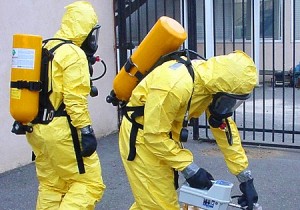September is National Preparedness Month. Visit NACCHO’s Preparedness Brief blog for more local public health preparedness news, tools, and resources.
By Laura Biesiadecki, Director of Strategic Partnerships, Outreach, and Education, Preparedness, NACCHO
“Our vision is a world safe and secure from global health threats posed by infectious diseases—where we can prevent or mitigate the impact of naturally occurring outbreaks and intentional or accidental releases of dangerous pathogens, rapidly detect and transparently report outbreaks when they occur, and employ an interconnected global network that can respond effectively to limit the spread of infectious disease outbreaks in humans and animals, mitigate human suffering and the loss of human life, and reduce economic impact.” –United States Government’s Global Health Security Vision [1]
 In February 2014, the United States joined 28 other countries, the World Health Organization, the Food and Agriculture Organization, and the World Organization for Animal Health to commit to goals specified within the Global Health Security Agenda, which contains a vision statement and nine objectives. As part of this commitment, the United States has developed the United States Global Health Security Strategy and pledged to work with at least 30 partner countries to prevent, detect, and effectively respond to infectious disease threats, whether naturally occurring or caused by accidental or intentional releases of dangerous pathogens, over the next five years. The President’s 2015 budget has proposed an additional $45 million to prevent avoidable catastrophes, detect threats early, and mobilize effective responses to contain outbreaks. The funds would also allow for programs to enhance workforce capacity by training field epidemiologists, developing new diagnostic tests, building capacities to detect new pathogens, and building public health emergency management capacity to support outbreak responses.[2] How implementing the Global Health Security Strategy will impact programming and funding for infectious disease preparedness over the next five years at the state and local levels remains to be seen.
In February 2014, the United States joined 28 other countries, the World Health Organization, the Food and Agriculture Organization, and the World Organization for Animal Health to commit to goals specified within the Global Health Security Agenda, which contains a vision statement and nine objectives. As part of this commitment, the United States has developed the United States Global Health Security Strategy and pledged to work with at least 30 partner countries to prevent, detect, and effectively respond to infectious disease threats, whether naturally occurring or caused by accidental or intentional releases of dangerous pathogens, over the next five years. The President’s 2015 budget has proposed an additional $45 million to prevent avoidable catastrophes, detect threats early, and mobilize effective responses to contain outbreaks. The funds would also allow for programs to enhance workforce capacity by training field epidemiologists, developing new diagnostic tests, building capacities to detect new pathogens, and building public health emergency management capacity to support outbreak responses.[2] How implementing the Global Health Security Strategy will impact programming and funding for infectious disease preparedness over the next five years at the state and local levels remains to be seen.
In May 2014, Dr. Thomas Frieden, Director of the Centers for Disease Control and Prevention (CDC), participated in the first Global Health Security Commitment Development Meeting in Helsinki, Finland, which was attended by 200 experts from 20 countries. The meeting marked an important opportunity for other countries to commit to accelerating global health security. Fewer than 20 percent of countries report that they are adequately prepared to effectively detect, respond to, or prevent global health threats caused by emerging diseases.[3] To address this issue, the CDC is combining resources and expertise with the Defense Threat Reduction Agency of the Department of Defense (DOD) to support demonstration projects in developing countries. In 2013, the CDC worked successfully with the Uganda Ministry of Health to implement upgrades in three areas: (1) strengthening the public health laboratory system by increasing the capacity of diagnostic and specimen referral networks; (2) enhancing the existing communications and information systems for outbreak response; and (3) developing a public health emergency operations center. In 2014, the CDC and DOD will commit $40 million to expand the list of demonstration site countries to include Ethiopia, Georgia, India, Jordan, Kazakhstan, Kenya, Philippines, South Africa, Tanzania, and Thailand.[4]
Over the past 12 years, catastrophic events such as 9/11, Hurricane Katrina, and the H1N1 influenza outbreak have led to large infusions of federal funding to state and local governments. However, such funding has been spent historically on disaster relief,[5] and funds are traditionally allocated categorically in response to events rather than sustained and directed to maintaining readiness. During the response and recovery phases of events, local health departments (LHDs) will increase programs and workforce but will eventually have to reduce staff and programming as funds are reduced. This cyclical response focused funding cycle creates inefficiencies and challenges in all levels of government and costs more than if the investment had been made in preparedness activities up front, leaving communities scrambling to respond to the next event.[6]
With public health preparedness funding and jobs shrinking, communities are vulnerable to emerging threats. From FY2012 to FY2013, the Department of Health and Human Services (HHS) cut $35 million from Public Health Emergency Preparedness funding and $20 million from the Hospital Preparedness Program.[7, 8] In January of FY2015, President Obama signed into law a federal spending bill that included a cut of over $100 million to the HHS Hospital Preparedness Program. That equals nearly a 30-percent reduction in a program specifically aimed at strengthening healthcare preparedness for public health emergencies. These cuts could have severe and dire consequences on the ability of communities to respond when disaster strikes. As indicated in the National Association of County and City Health Officials’ 2010 National Profile of Local Health Departments (Profile) report, 59 percent of LHDs relied solely on federal funding for public health preparedness. The 2013 Profile report shows that 23 percent of LHDs reduced or eliminated at least one emergency preparedness program in 2011, and the trend continued in 2012 with a 15-percent reduction.
As funding concerns persist, LHDs’ responsibility to remain vigilant to threats remains constant. Not only must LHDs be watchful of global health infectious disease threats, they must also acknowledge and plan for emerging threats both natural and manmade. Two examples of emerging threats related to global health security that may involve LHDs are cyber attacks on healthcare facilities and health threats that result from climate change.
Cyber Attacks
 A cyber attack on a healthcare facility could disrupt the facility’s capacity to manage patients, prevent the facility from managing routine care, and impede the facility from handling patient surge during catastrophic events. Cyber attacks could result in identity theft or loss of patient information should personal data be exposed. Patients and practitioners might lose confidence in a healthcare provider’s ability to maintain patient privacy. System outages might disrupt care.[9]
A cyber attack on a healthcare facility could disrupt the facility’s capacity to manage patients, prevent the facility from managing routine care, and impede the facility from handling patient surge during catastrophic events. Cyber attacks could result in identity theft or loss of patient information should personal data be exposed. Patients and practitioners might lose confidence in a healthcare provider’s ability to maintain patient privacy. System outages might disrupt care.[9]
Current policy falls short of protecting the health sector from cyber threats. To foster the improvements of the healthcare delivery system, federal guidance to state and local health departments has promoted the adoption of technology in healthcare facilities. From the executive level, President Obama issued Presidential Policy Directive (PPD) 21 and Executive Order (EO) 13636: Improving Critical Infrastructure Cybersecurity, emphasizing the need for holistic thinking about critical infrastructure security and risk management. Those directives and executive orders will drive action toward critical infrastructure systems—including healthcare—to improve network security. Additionally, those policies will help promote and incentivize the adoption of cyber security practices, increase cyber threat information-sharing, evaluate and mature public-private partnerships, and demonstrate the cascading consequences of infrastructure failures. With the release of PPD 21 and EO 13636 and their subsequent implementation, federal agencies responsible for managing preparedness funds should prioritize improving security of healthcare information systems, strengthening public-private partnerships vital to healthcare cyber security and resiliency, and adopting standards and frameworks for information-sharing and security.
Climate Change-Related Health Threats
 The health threats that result from climate change will be inherently local, and LHDs may be best equipped to protect their communities from these threats. Such threats may include extreme weather events, wildfires, decreased air quality, threats to mental health, and illnesses transmitted by food, water, and disease carriers such as mosquitoes and ticks.[10] LHDs play an important role in preventing and preparing for the impacts of climate change. LHDs inform local policy and implement strategies to face the illnesses and potential deaths related to environmental exposure as a result of increased severe weather events, drought, and temperatures associated with climate change. The health impacts of climate change will vary community by community. LHDs can help forecast the health impacts in a region, county, or city and help community organizations, healthcare providers, and other stakeholders work to prevent the impacts of climate change and prepare for and address the impacts already occurring.
The health threats that result from climate change will be inherently local, and LHDs may be best equipped to protect their communities from these threats. Such threats may include extreme weather events, wildfires, decreased air quality, threats to mental health, and illnesses transmitted by food, water, and disease carriers such as mosquitoes and ticks.[10] LHDs play an important role in preventing and preparing for the impacts of climate change. LHDs inform local policy and implement strategies to face the illnesses and potential deaths related to environmental exposure as a result of increased severe weather events, drought, and temperatures associated with climate change. The health impacts of climate change will vary community by community. LHDs can help forecast the health impacts in a region, county, or city and help community organizations, healthcare providers, and other stakeholders work to prevent the impacts of climate change and prepare for and address the impacts already occurring.
Cybersecurity and environment and global climate change are just two examples of evolving issues of concern for global and domestic health security. During the 2015 Preparedness Summit on April 14–17, preparedness professionals from across the nation and globe will meet in Atlanta to discuss the evolving vision for global health security and emerging issues that threaten community safety.
This article was originally published in NACCHO Exchange. To read the entire issue, download the newsletter from NACCHO’s online bookstore (login required).








